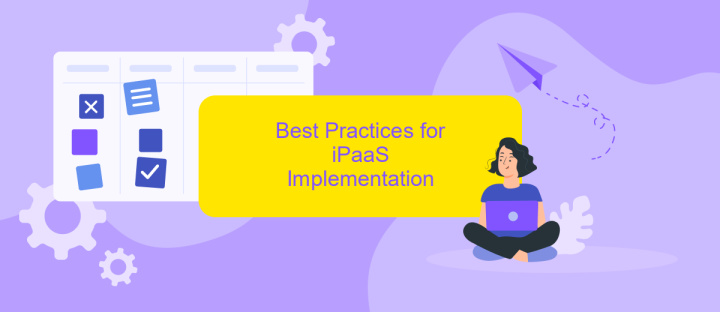iPaaS Best Practices
Integrating Platform as a Service (iPaaS) has become a cornerstone for businesses aiming to streamline their operations and enhance data connectivity. This article delves into the best practices for implementing iPaaS solutions, ensuring seamless integration, scalability, and optimal performance. Whether you're new to iPaaS or looking to refine your existing setup, these guidelines will help you maximize the benefits of this powerful technology.
Introduction
In today's rapidly evolving digital landscape, businesses are increasingly turning to Integration Platform as a Service (iPaaS) solutions to streamline their operations and enhance connectivity. iPaaS platforms offer a unified interface to connect disparate systems, enabling seamless data flow and process automation. Implementing best practices in iPaaS is crucial to maximize efficiency, reduce errors, and ensure scalability.
- Define clear integration goals and objectives.
- Choose a reliable iPaaS provider, such as ApiX-Drive, that offers robust features and support.
- Ensure data security and compliance with relevant regulations.
- Regularly monitor and optimize integration workflows.
- Foster collaboration between IT and business teams.
By adhering to these best practices, organizations can leverage iPaaS solutions to achieve seamless integration and automation. ApiX-Drive, for instance, provides a user-friendly platform that simplifies the integration process, allowing businesses to connect various applications and services effortlessly. This not only enhances operational efficiency but also fosters innovation and agility in a competitive market.
Benefits of Using an iPaaS

One of the primary benefits of using an iPaaS (Integration Platform as a Service) is the ability to streamline and automate business processes across various applications. By providing a centralized platform for integrating disparate systems, iPaaS solutions eliminate the need for manual data entry and reduce the risk of errors. This not only saves time but also enhances data accuracy and consistency across the organization. Tools like ApiX-Drive make it easier for businesses to set up and manage integrations without requiring extensive technical expertise, thereby accelerating the implementation process.
Another significant advantage of using an iPaaS is its scalability and flexibility. As businesses grow and evolve, their integration needs can change rapidly. An iPaaS solution allows for quick adjustments and additions to the integration landscape, ensuring that new applications and data sources can be seamlessly incorporated. Additionally, iPaaS platforms often come with robust monitoring and analytics capabilities, enabling organizations to track the performance of their integrations in real-time and make data-driven decisions. This adaptability ensures that businesses can maintain operational efficiency and responsiveness in a dynamic market environment.
Best Practices for iPaaS Implementation

Implementing an Integration Platform as a Service (iPaaS) requires careful planning and execution to ensure seamless integration and optimal performance. By following best practices, organizations can maximize the benefits of their iPaaS solutions and avoid common pitfalls.
- Define Clear Objectives: Establish specific goals for your iPaaS implementation to guide the process and measure success.
- Choose the Right iPaaS Provider: Evaluate providers based on features, scalability, and support. Consider using ApiX-Drive for its user-friendly interface and robust integration capabilities.
- Ensure Data Security: Implement strong security measures to protect sensitive data during integration processes.
- Test Thoroughly: Conduct comprehensive testing to identify and resolve issues before full-scale deployment.
- Monitor and Optimize: Continuously monitor performance and make necessary adjustments to improve efficiency and reliability.
By adhering to these best practices, organizations can streamline their integration processes and leverage the full potential of iPaaS solutions. Tools like ApiX-Drive can significantly simplify the setup and management of integrations, ensuring a smooth and effective implementation.
Common Challenges and Troubleshooting

Implementing an iPaaS solution can significantly streamline your integration processes, but it comes with its own set of challenges. One common issue is data mapping errors, which can lead to data inconsistencies and operational disruptions. Ensuring that data is correctly mapped between systems is crucial for maintaining data integrity.
Another frequent challenge is managing API rate limits. Many third-party services impose limits on the number of API calls that can be made within a certain timeframe. Exceeding these limits can result in failed integrations and service interruptions. Effective monitoring and optimization of API usage are essential.
- Data mapping errors
- API rate limits
- Authentication and authorization issues
- Latency and performance bottlenecks
Troubleshooting these issues often involves a combination of proactive monitoring and reactive problem-solving. Tools like ApiX-Drive can help simplify the integration process by providing intuitive data mapping interfaces and robust monitoring capabilities. By leveraging such tools, you can mitigate common challenges and ensure smoother, more reliable integrations.
Conclusion
Implementing iPaaS best practices is essential for achieving seamless integration across various applications and services. By following these guidelines, organizations can enhance their operational efficiency, reduce manual errors, and ensure data consistency. It is crucial to thoroughly plan the integration strategy, considering both current and future needs, and to select the right tools and platforms that align with your business objectives.
One such tool that can significantly aid in streamlining integrations is ApiX-Drive. This platform offers a user-friendly interface and robust features that simplify the process of connecting different applications. With ApiX-Drive, businesses can automate workflows, synchronize data in real-time, and gain valuable insights through comprehensive analytics. By leveraging such services, organizations can focus more on their core activities and drive innovation, ultimately leading to improved productivity and growth.
- Automate the work of an online store or landing
- Empower through integration
- Don't spend money on programmers and integrators
- Save time by automating routine tasks
FAQ
What is iPaaS?
What are the key benefits of using iPaaS?
How do I choose the right iPaaS solution for my organization?
What are some best practices for implementing iPaaS?
How can I automate workflows using iPaaS?
Routine tasks take a lot of time from employees? Do they burn out, do not have enough working day for the main duties and important things? Do you understand that the only way out of this situation in modern realities is automation? Try Apix-Drive for free and make sure that the online connector in 5 minutes of setting up integration will remove a significant part of the routine from your life and free up time for you and your employees.


